Named-Entity-Recognition-Based Automated System for Diagnosing Cybersecurity Situations in IoT Networks
Abstract
1. Introduction
2. Related Works
- designing a framework for the automated extraction of information related to IoT found within the database of available CVEs using semantic analysis as an input stage for automatic context-based filtering within the CVEs database;
- extracting training data using a list of keywords in the form of a sub-set of CVEs associated with IoT systems;
- creating a domain-based ontology for vulnerability information within IoT systems;
- addressing optimization issues within the general concept of cyber situation awareness in order to integrate it into the process of security information risk management.
3. Security Vulnerabilities for IoT Technologies
4. Using NER for the Automatic Gathering of Cybersecurity Data Regarding IoT Devices
4.1. The Solution’s Architecture
4.2. Choosing Technologies
4.3. The Ontology
4.4. Developing the NER Model
4.4.1. From Ontology to Entity Recognition
- It can identify new forms of the instances that are already defined in the ontology;
- It can identify new class instances similar to the existing ones.
4.4.2. Training the Model
4.4.3. Data Storage
- As an artificial intelligence solution that connects with the Knowledge Studio service and performs entity recognition based on models created in Knowledge Studio. Within Watson Discovery, document feeds can be automatically uploaded via a REST API. These are enriched with annotations and, for each document, a JSON with metadata is returned.
- Both as a cognitive text analysis solution (according to point 1) and as a storage solution for uploaded documents. Documents can be stored directly in Watson Discovery to be used at an aggregate level directly in the IBM Cloud platform. This makes work easier, as there is no need to develop new storage components. On the other hand, the IBM Cloud service is commercial, and the storage of a large volume of documents involves some costs. For this article, no costs were involved, as we used free accounts created by IBM for research purposes.
4.4.4. Validating the Model
4.5. Data Output—API
5. Semantic Security Gateway
- (1)
- enriched_text.entities:(text:Samsung,type:Vendor),enriched_text.entities:(text:Tizen OS,type:Software);
- (2)
- enriched_text.entities:(text:Insteon Hub,type:Thing),enriched_text.entities:(text:”firmware version 1016”,type:Software),enriched_text.entities:(text:REST API).
6. Limitations
7. Conclusions
Author Contributions
Funding
Conflicts of Interest
Appendix A
| No. | Key Term | Description | CVEs |
|---|---|---|---|
| 1 | Actuator | physical component | CVE-2014-9786, CVE-2014-9782, CVE-2014-9877 |
| 2 | AMQP | protocol | CVE-2018-8119, CVE-2018-8030, CVE-2018-1298, CVE-2018-11087, CVE-2018-11050, CVE-2017-8045, CVE-2017-15702, CVE-2017-15701, CVE-2017-15699, CVE-2017-11408, CVE-2016-4974, CVE-2016-4432, CVE-2016-2173, CVE-2015-5240, CVE-2015-0862, CVE-2015-0203, CVE-2014-8711, CVE-2014-2814, CVE-2012-4458, CVE-2012-4446, CVE-2012-3467 |
| 3 | Arduino | platform | CVE-2018-17614, CVE-2015-7833, CVE-2015-4590 |
| 4 | Barcode | technology | CVE-2018-5221, CVE-2014-8672, CVE-2014-7897, CVE-2014-6869 |
| 5 | Belkin WeMo | product | CVE-2018-6692, CVE-2013-6952, CVE-2013-6951, CVE-2013-6950, CVE-2013-6949, CVE-2013-6948 |
| 6 | CoAP | protocol | CVE-2018-18225, CVE-2018-14367 |
| 7 | Eclipse Kura | framework | CVE-2017-7649 |
| 8 | Eclipse Mosquitto | framework | CVE-2018-12543, CVE-2017-9868, CVE-2017-9132, CVE-2017-9131, CVE-2017-7654, CVE-2017-7653, CVE-2017-7652, CVE-2017-7651, CVE-2017-7650 |
| 9 | Embedded system | technology | CVE-2017-12823 |
| 10 | HART | protocol | CVE-2018-16059, CVE-2015-6463, CVE-2015-3977, CVE-2014-9203, CVE-2014-9191, CVE-2013-2476 |
| 11 | Home automation | solution | CVE-2015-3610, CVE-2014-4892, CVE-2013-6952, CVE-2013-6951, CVE-2013-6950, CVE-2013-6949, CVE-2013-6948 |
| 12 | Homekit | solution | CVE-2017-13903, CVE-2017-2434 |
| 13 | IIoT | technology | CVE-2018-18396, CVE-2018-18395, CVE-2018-18394, CVE-2018-18394, CVE-2018-18393, CVE-2018-18392, CVE-2018-18391, CVE-2018-18390 |
| 14 | Insteon | product | CVE-2018-3834, CVE-2018-3833, CVE-2018-3832, CVE-2018-12640, CVE-2018-11560, CVE-2017-5251, CVE-2017-5250, CVE-2017-16348, CVE-2017-16347, CVE-2017-16346, CVE-2017-16345, CVE-2017-16344, CVE-2017-16343, CVE-2017-16342, CVE-2017-16341, CVE-2017-16340, CVE-2017-16339, CVE-2017-16338, CVE-2017-16337, CVE-2017-16252, CVE-2017-14455, CVE-2017-14453, CVE-2017-14452, CVE-2017-14447, CVE-2017-14446, CVE-2017-14445, CVE-2017-14444, CVE-2017-14443 |
| 15 | IoT | technology | CVE-2018-8531, CVE-2018-8479, CVE-2018-8119, CVE-2018-12163, CVE-2018-11682, CVE-2018-11681, CVE-2018-11629, CVE-2018-0270, CVE-2017-7911, CVE-2017-7243, CVE-2017-6780, CVE-2017-14913, CVE-2017-14912, CVE-2017-14911, CVE-2017-14910, CVE-2017-14906, CVE-2017-11010, CVE-2015-4080, CVE-2015-2247. |
| 16 | MQTT (Message Queuing Telemetry Transport) | protocol | CVE-2018-8531, CVE-2018-18765, CVE-2018-18764, CVE-2018-17614, CVE-2018-17614, CVE-2018-1684, CVE-2018-1684, CVE-2018-15323, CVE-2017-9868, CVE-2017-7651, CVE-2017-7650, CVE-2017-7296, CVE-2017-2895, CVE-2017-2894, CVE-2017-2893, CVE-2017-2892, CVE-2016-9877, CVE-2016-10523, CVE-2014-6116, CVE-2014-0923, CVE-2014-0922 |
| 17 | NFC | technology | CVE-2018-7930, CVE-2017-2287, CVE-2017-2286, CVE-2017-2149, CVE-2017-17280, CVE-2017-17225, CVE-2017-15322, CVE-2017-0784, CVE-2017-0481, CVE-2016-3761, CVE-2015-8041, CVE-2015-4033 |
| 18 | OSRAM Lightify lights | product | CVE-2016-5059, CVE-2016-5058, CVE-2016-5057, CVE-2016-5056, CVE-2016-5055, CVE-2016-5054, CVE-2016-5053, CVE-2016-5052, CVE-2016-5051 |
| 19 | Philips Hue | product | CVE-2017-14797 |
| 20 | QR code | technology | CVE-2018-3900, CVE-2018-3899, CVE-2018-3898, CVE-2017-7696, CVE-2014-8672, CVE-2014-3651, CVE-2014-0239, CVE-2013-4872 |
| 21 | RFID | technology | CVE-2018-5304, CVE-2018-5303, CVE-2018-4833, CVE-2015-6839, CVE-2013-0656 |
| 22 | RPL | protocol | CVE-2014-3405 |
| 23 | Sensor | physical component | CVE-2018-9276, CVE-2018-19204, CVE-2018-14891, CVE-2018-14890, CVE-2018-14889, CVE-2018-11399, CVE-2018-0453, CVE-2017-6798, CVE-2017-15814, CVE-2017-15008, CVE-2017-0709, CVE-2017-0582, CVE-2017-0527, CVE-2017-0526, CVE-2017-0519, CVE-2017-0518, CVE-2017-0517, CVE-2016-9568, CVE-2016-4038, CVE-2016-3934, CVE-2016-3903, CVE-2016-3798, CVE-2016-2398, CVE-2016-2311, CVE-2016-0866, CVE-2016-0865, CVE-2016-0864, CVE-2016-0863, CVE-2015-7743, CVE-2015-2878, CVE-2015-0739, CVE-2014-9890, CVE-2014-9877, CVE-2014-9868, CVE-2014-9866, CVE-2014-9786, CVE-2014-9783, CVE-2014-9782, CVE-2014-2362, CVE-2014-2361, CVE-2014-2360, CVE-2014-2359, CVE-2013-6124, CVE-2013-5321, CVE-2013-1219, CVE-2012-4621 |
| 24 | Sensors | physical components | CVE-2018-5401, CVE-2018-1000044, CVE-2018-0453, CVE-2017-18303, CVE-2017-12879, CVE-2016-2813, CVE-2014-2379, CVE-2014-2378, CVE-2013-1243, CVE-2012-3901, CVE-2012-3899 |
| 25 | Smart home | solution | CVE-2018-9162, CVE-2018-15125, CVE-2018-15124, CVE-2018-15123, CVE-2017-5249, CVE-2014-4892 |
| 26 | Smartgrid | solutions | CVE-2016-0866, CVE-2016-0865, CVE-2016-0864, CVE-2016-0863 |
| 27 | Smarthome | solution | CVE-2017-2704 |
| 28 | SmartThings | product, hub | CVE-2018-3927, CVE-2018-3926, CVE-2018-3925, CVE-2018-3919, CVE-2018-3918, CVE-2018-3917, CVE-2018-3916, CVE-2018-3915, CVE-2018-3914, CVE-2018-3913, CVE-2018-3912, CVE-2018-3911, CVE-2018-3909, CVE-2018-3908, CVE-2018-3907, CVE-2018-3906, CVE-2018-3905, CVE-2018-3904, CVE-2018-3903, CVE-2018-3902, CVE-2018-3897, CVE-2018-3896, CVE-2018-3895, CVE-2018-3894, CVE-2018-3893, CVE-2018-3880, CVE-2018-3879, CVE-2018-3878, CVE-2018-3877, CVE-2018-3876, CVE-2018-3875, CVE-2018-3874, CVE-2018-3873, CVE-2018-3872, CVE-2018-3867, CVE-2018-3866, CVE-2018-3865, CVE-2018-3864, CVE-2018-3863, CVE-2018-3856 |
| 29 | Vehicle | physical component | CVE-2018-18071, CVE-2017-1000474, CVE-2016-9337, CVE-2016-2354, CVE-2015-5611 |
| 30 | Vehicles | physical component | CVE-2018-9322, CVE-2018-9320, CVE-2018-9318, CVE-2018-9314, CVE-2018-9313, CVE-2018-9312, CVE-2018-9311, CVE-2018-18070, CVE-2018-16806, CVE-2017-9647, CVE-2017-9633, CVE-2017-14937 |
| 31 | Wearable | technology | CVE-2017-17773 |
| 32 | Wink | product | CVE-2017-5249 |
| 33 | Zigbee | protocol | CVE-2018-3926, CVE-2016-5058, CVE-2016-5054, CVE-2016-2398, CVE-2016-1562, CVE-2015-8732, CVE-2015-6244 |
References
- Ashton, K. That ‘internet of things’ thing. RFID J. 2009, 22, 97–114. [Google Scholar]
- Palermo, F. Information Week. Available online: https://www.informationweek.com/strategic-cio/executive-insights-and-innovation/internet-of-things-done-wrong-stifles-innovation/a/d-id/1279157 (accessed on 3 March 2018).
- Georgescu, T.M.; Iancu, B. An IoT architecture that uses semantic reasoning based security. In Proceedings of the 17th International Conference on Informatics in Economy (IE 2018), Iasi, Romania, 17–20 May 2018. [Google Scholar]
- Lin, H.; Bergmann, N.W. IoT Privacy and Security Challenges for Smart Home Environments. Information 2016, 7, 44. [Google Scholar] [CrossRef]
- Jurn, J.; Kim, T.; Kim, H. An Automated Vulnerability Detection and Remediation Method for Software Security. Sustainability 2018, 10, 1652. [Google Scholar] [CrossRef]
- MITRE Corporation. Common Vulnerabilities and Exposures. Available online: https://cve.mitre.org/ (accessed on 11 November 2018).
- Joshi, A.; Lal, R.; Finin, T.; Joshi, A. Extracting cybersecurity related linked data from text. In Proceedings of the 2013 IEEE Seventh International Conference on Semantic Computing, Irvine, CA, USA, 16–18 September 2013. [Google Scholar]
- Ficco, M. Security event correlation approach for cloud computing. Int. J. High Perform. Comput. Netw. 2013, 7, 173–185. [Google Scholar] [CrossRef]
- Alam, S.; Chowdhury, M.M.R.; Noll, J. Interoperability of Security-Enabled Internet of Things. Wirel. Pers. Commun. 2011, 61, 567–586. [Google Scholar] [CrossRef]
- Tao, M.; Zuo, J.; Liu, Z.; Castiglione, A.; Palmieri, F. Multi-layer cloud architectural model and ontology-based security service framework for IoT-based smart homes. Future Gener. Comput. Syst. 2018, 78, 1040–1051. [Google Scholar] [CrossRef]
- Marotta, A.; Martinelli, F.; Nanni, S.; Orlando, A.; Yautsiukhin, A. Cyber-insurance survey. Comput. Sci. Rev. 2014, 24, 35–61. [Google Scholar] [CrossRef]
- Ekelhart, A.; Fenz, S.; Neubauer, T. AURUM: A Framework for Information Security Risk Management. In Proceedings of the 2009 42nd Hawaii International Conference on System Science, Big Island, HI, USA, 5–8 January 2009; pp. 1–10. [Google Scholar]
- Poonia, A.S.; Banerjee, C.; Banerjee, A.; Sharma, S.K. Vulnerability Identification and Misuse Case Classification Framework; Springer: Singapore, 2018; pp. 659–666. [Google Scholar]
- Sauerwein, C.; Pekaric, I.; Felderer, M.; Breu, R. An analysis and classification of public information security data sources used in research and practice. Comput. Secur. 2019, 82, 140–155. [Google Scholar] [CrossRef]
- Liang, A.; Liu, R.; Zhang, X.; Chen, Y.; Li, K.; Wang, J. An Inside Look at IoT Malware. In Proceedings of the International Conference on Industrial IoT Technologies and Applications, Wuhu, China, 25–26 March 2017; pp. 176–186. [Google Scholar]
- Knud, S.; Skouby, E.; Tweneboah-Koduah, R.T. Cyber security threats to IoT applications and service domains. Wirel. Pers. Commun. 2017, 95, 169–185. [Google Scholar]
- Tsoumas, B.; Gritzalis, D. Towards an Ontology-based Security Management. In Proceedings of the 20th International Conference on Advanced Information Networking and Applications, Vienna, Austria, 18–20 April 2006. [Google Scholar]
- Neuhaus, S.; Zimmermann, T. Security Trend Analysis with CVE Topic Models. In Proceedings of the 2010 IEEE 21st International Symposium on Software Reliability Engineering, San Jose, CA, USA, 1–4 November 2010. [Google Scholar]
- Chang, Y.Y.; Zavarsky, P.; Ruhl, R.; Lindskog, D. Trend Analysis of the CVE for Software Vulnerability Management. In Proceedings of the IEEE Third International Conference on Privacy, Security, Risk and Trust (PASSAT), Boston, MA, USA, 9–11 October 2011; Volume 1, pp. 1290–1293. [Google Scholar]
- Montesino, R.; Fenz, S. Automation possibilities in information security management. In Proceedings of the 2011 European Intelligence and Security Informatics Conference, Athens, Greece, 12–14 September 2011. [Google Scholar]
- Barford, P.; Dacier, M.; Dietterich, T.G.; Fredrikson, M.; Giffin, J.; Jajodia, S.; Jha, S.; Li, J.; Liu, P.; Ning, P.; et al. Cyber SA: Situational Awareness for Cyber Defence. Adv. Inf. Secur. 2010, 46, 3–13. [Google Scholar]
- Li, J.; Ou, X.; Rajagopalan, R. Uncertainty and Risk Management in Cyber Situational Awareness. In Proceedings of the ARO Workshop on Cyber Situational Awareness, Fairfax, VA, USA, 3–4 March 2009. [Google Scholar]
- Webb, J.; Ahmad, A.; Maynard, S.B.; Shanks, G. A Situation Awareness Model for Information Security Risk Management. Comput. Secur. 2014, 44, 1–15. [Google Scholar] [CrossRef]
- Liu, J.; Feng, X.; Li, J.; Wang, D. Cyber Security Situation Awareness Based on Data Mining. In Proceedings of the 2012 2nd International Conference on Computer and Information Application (ICCIA 2012), Taiyuan, China, 8–9 December 2012; pp. 254–258. [Google Scholar]
- Arnaert, M.; Bertrand, Y.; Boudaoud, K. Modeling Vulnerable Internet of Things on SHODAN and CENSYS: An Ontology for Cyber Security. In Proceedings of the Tenth International Conference on Emerging Security Information, Systems and Technologies (SECUREWARE 2016), Nice, France, 24–28 July 2016; pp. 299–302. [Google Scholar]
- Angelelli, C.; Linton, L.A.; Singh, J.; Muresan, H.; Palmer, M. Cognitive Cyber Security Assistants—Computationally Deriving Cyber Intelligence and Course of Actions. In AAAI Fall Symposium Series: Cognitive Assistance in Gorvernment and Public Sector Applications; Technicel Report FS-16-02; The AAAI Press: Palo Alto, CA, USA, 2016. [Google Scholar]
- NeCamp, T.; Sattigeri, P.; Wei, D.; Ray, E.; Drissi, Y.; Poddar, A.; Mahajan, D.; Bowden, S.; Han, B.A.; Mojsilovic, A.; et al. Cognitive Disease Hunter: Developing Automated Pathogen Feature Extraction from Scientific Literature. 2017. Available online: https://dssg.uchicago.edu/wp-content/uploads/2017/09/necamp.pdf (accessed on 11 November 2018).
- Tonin, L. Annotating Mentions of Coronary Artery Disease in Medical Reports. 2017. Available online: https://pdfs.semanticscholar.org/20a1/442bd186f446899539d2173f7168090e08fa.pdf (accessed on 11 November 2018).
- Fritzner, J.E.H. Automated Information Extraction in Natural Language. Master’s Thesis, Norwegian University of Science and Technology, Trondheim, Norway, 2017. [Google Scholar]
- National Vulnerability Database. Available online: https://nvd.nist.gov/ (accessed on 9 January 2019).
- Boja, C.; Zamfiroiu, A.; Iancu, B.; Georgescu, T.M.; Cartas, C.; Toma, C. Avant-Garde Technology Hub for Advanced Security—Technical Study; Military Technical Academy: Bucharest, Romania, 2018. [Google Scholar]
- Georgescu, T.M. Cybersecurity Analyzer. Available online: http://www.cybersecurityanalyzer.com/ (accessed on 9 January 2019).
- Stanford University School of Medicine Stanford Center for Biomedical Informatics Research. Protege. Available online: https://protege.stanford.edu/ (accessed on 5 December 2018).
- IBM (International Business Machines). IBM Cloud. Available online: https://console.bluemix.net/docs/services/knowledge-studio/index.html#wks_overview_full (accessed on 9 January 2019).
- IBM (International Business Machines). IBM Cloud. Available online: https://console.bluemix.net/docs/services/discovery/index.html#about (accessed on 9 January 2019).
- Postman. Available online: https://www.getpostman.com/ (accessed on 9 January 2019).
- Iannacone, M.; Bohn, S.; Nakamura, G.; Gerth, J.; Huffer, K.; Bridges, R.A.; Ferragut, E.; Goodall, J.R. Developing an ontology for cyber security knowledge graphs. In Proceedings of the 10th Annual Cyber and Information Security Research Conference, Oak Ridge, TN, USA, 7–9 April 2015; p. 12. [Google Scholar]
- Nadeau, D.; Sekine, S. A survey of named entity recognition and classification. Linguist. Investig. 2007, 30, 3–26. [Google Scholar]
- CoNLL 2018 Shared Task. Evaluation. 2018. Available online: https://universaldependencies.org/conll18/evaluation.html (accessed on 9 January 2019).
- Cruz, T.; Simões, P.; Reis, N.; Monteiro, E.; Bastos, F.; Laranjeira, A. An Architecture for Virtualized Home Gateways. In Proceedings of the IFIP/IEEE International Symposium on Integrated Network Management (IM 2013), Ghent, Belgium, 27–31 May 2013. [Google Scholar]
- Alirezaie, M.; Renoux, J.; Köckemann, U.; Kristoffersson, A.; Karlsson, L.; Blomqvist, E.; Tsiftes, N.; Voigt, T.; Loutfi, A. An ontology-based context-aware system for smart homes: E-care@ home. Sensors 2017, 17, 1586. [Google Scholar] [CrossRef]
- Iancu, B.; Georgescu, T.M. Saving Large Semantic Data in Cloud: A Survey of the Main DBaaS Solutions. Inform. Econ. 2018, 22, 5–16. [Google Scholar] [CrossRef]
- Costea, C.; Petrovan, A.; Neamt, L.; Chiver, O. On performing semantic queries in small devices. IOP Conf. Ser. Mater. Sci. Eng. 2016, 144. [Google Scholar] [CrossRef]
- Berners-Lee, T. Inrupt—One Small Step for the Web…. 28 September 2018. Available online: https://www.inrupt.com/blog/one-small-step-for-the-web (accessed on 9 January 2019).
- Boja, C.; Zurini, M. IoT Security Architecture Based on Device Fingerprinting. In Proceedings of the IE 2018 International Conference, Iași, Romania, 17–20 May 2018. [Google Scholar]
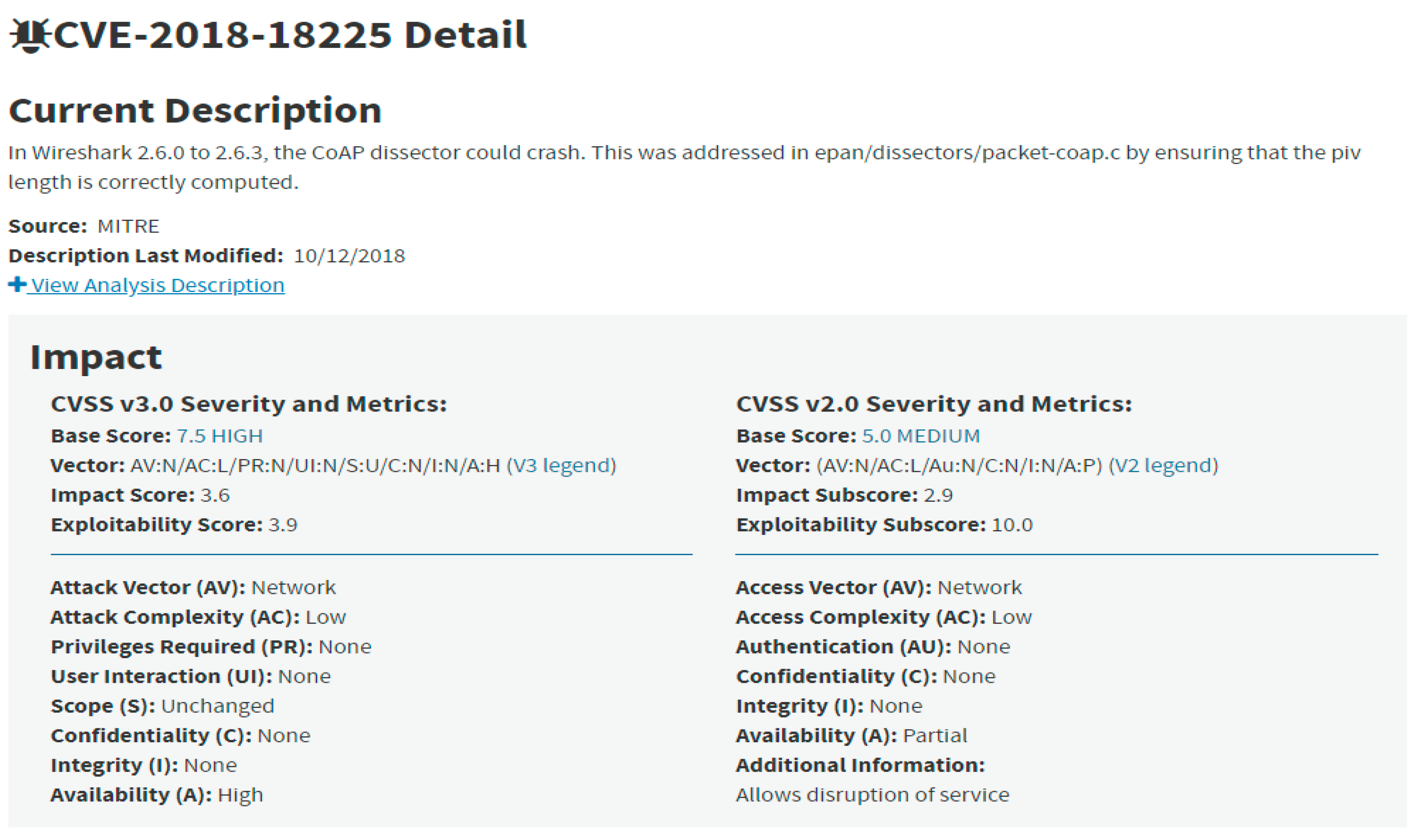
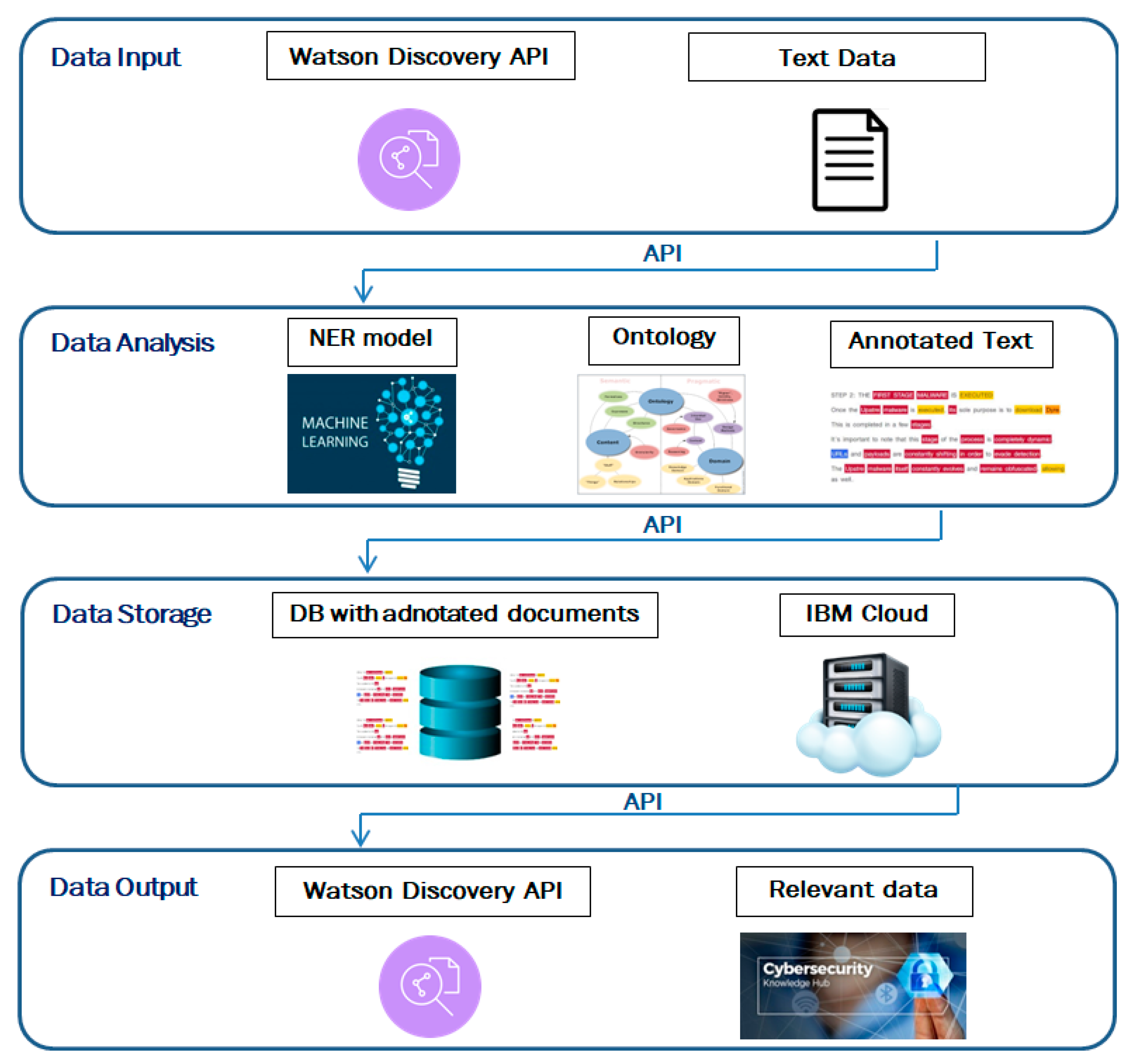
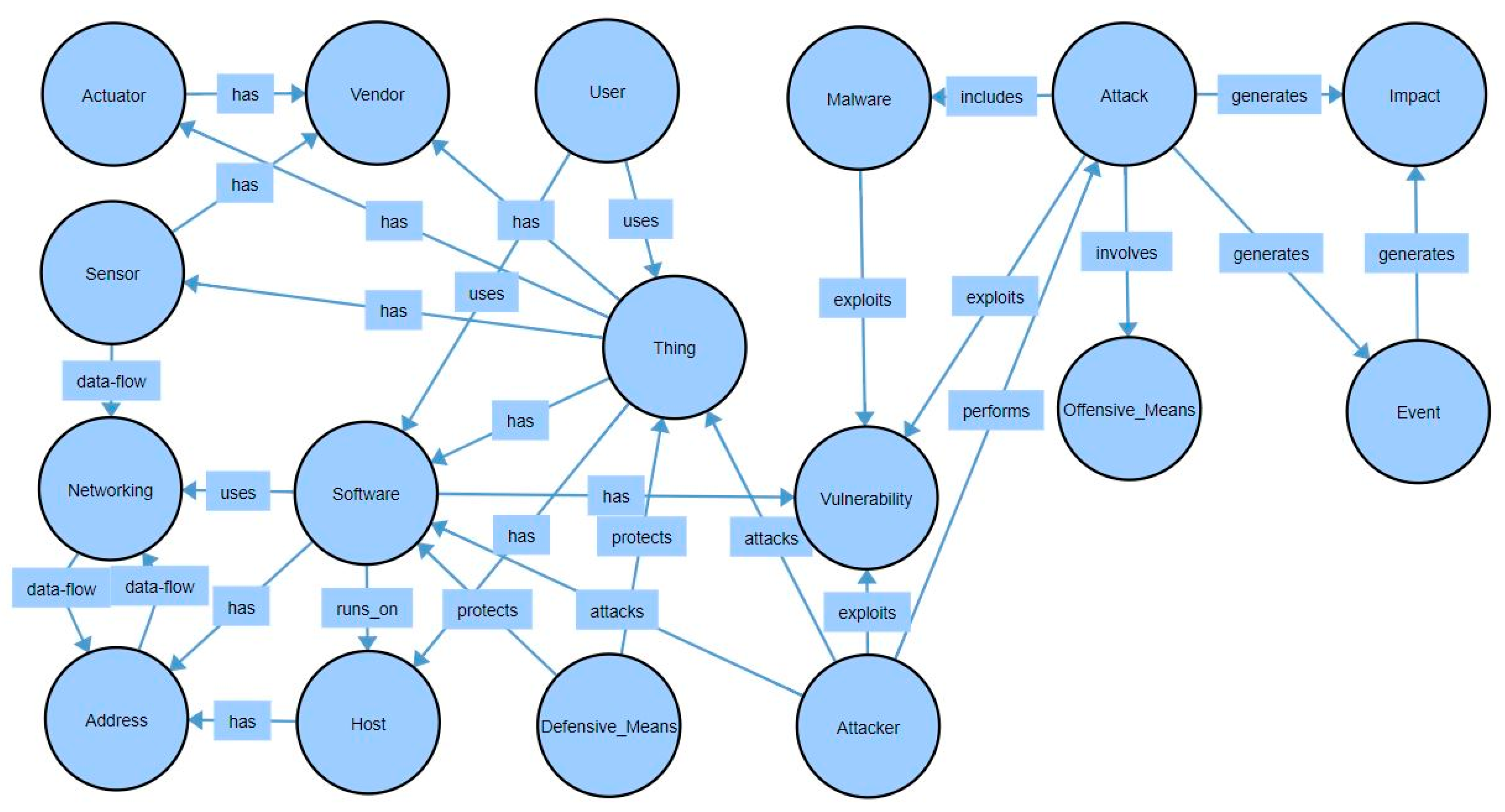
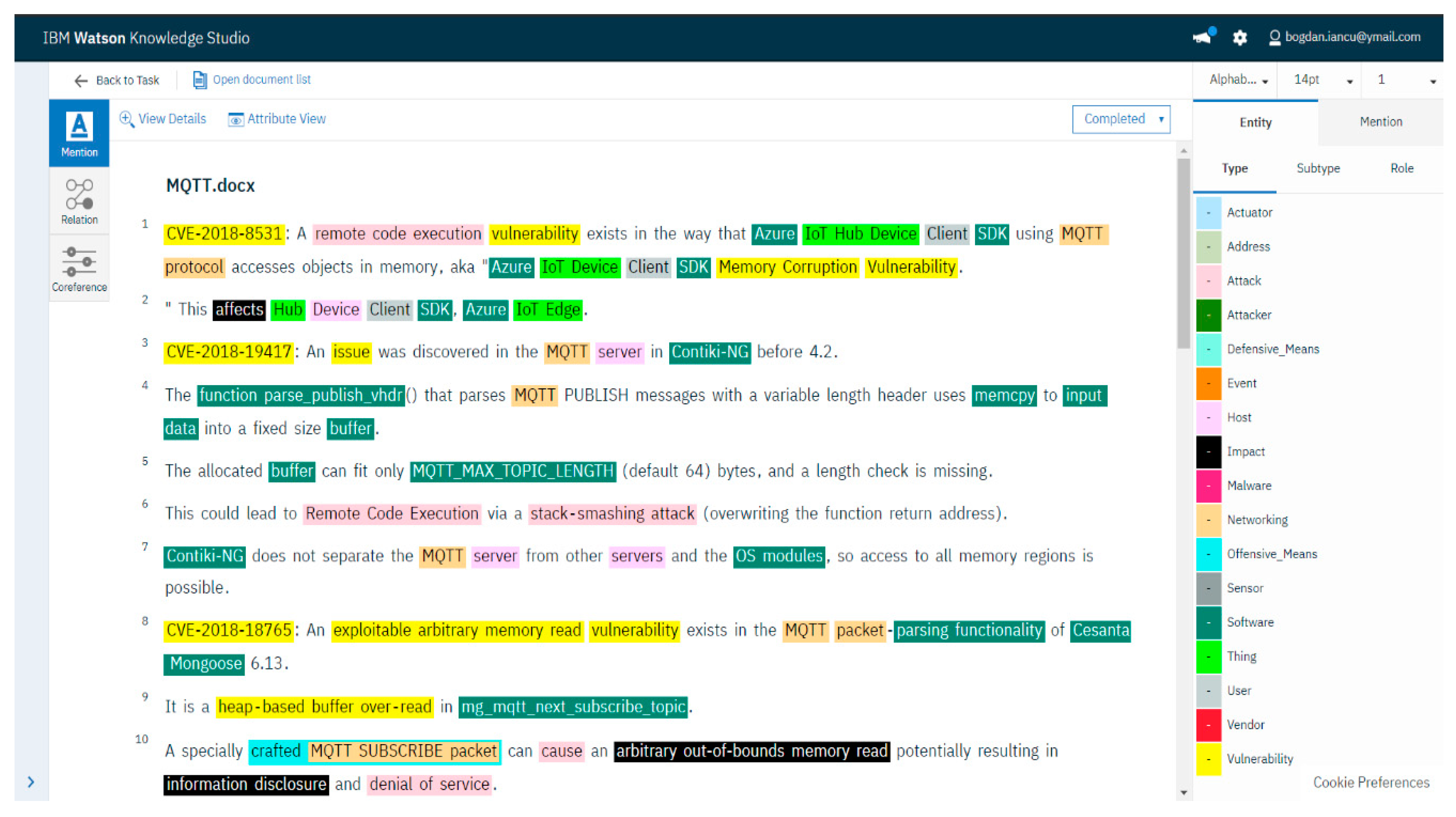
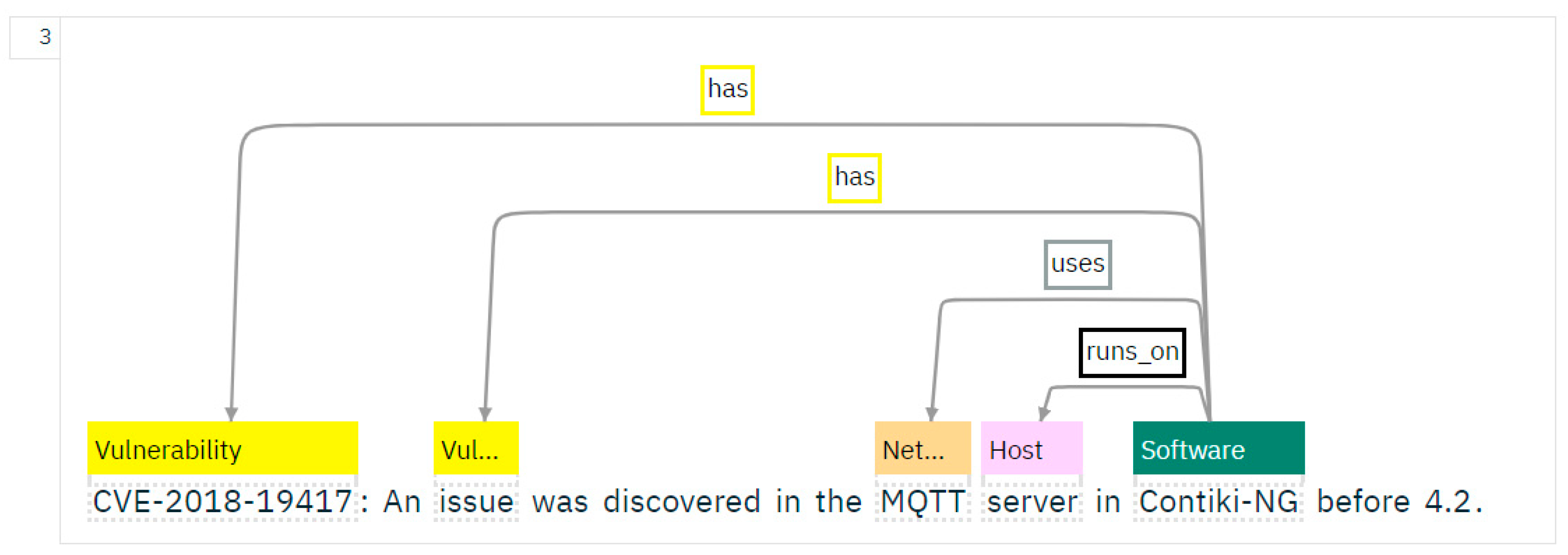
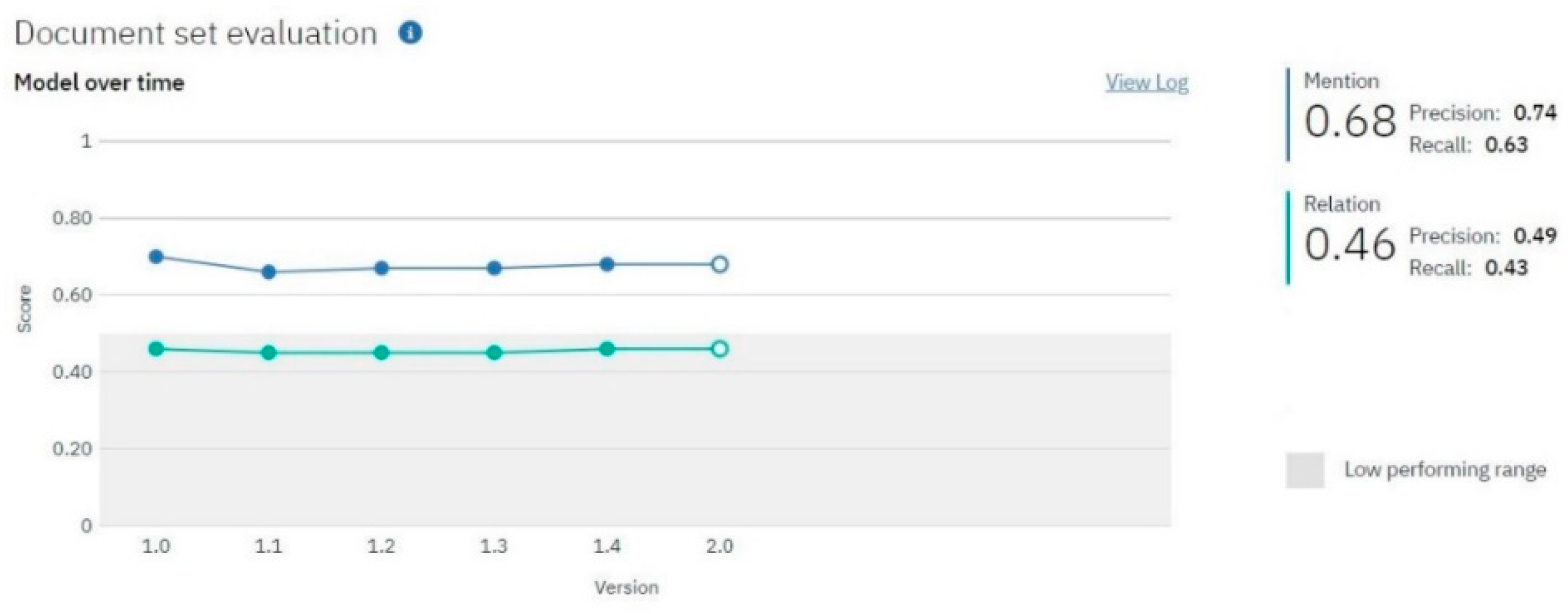
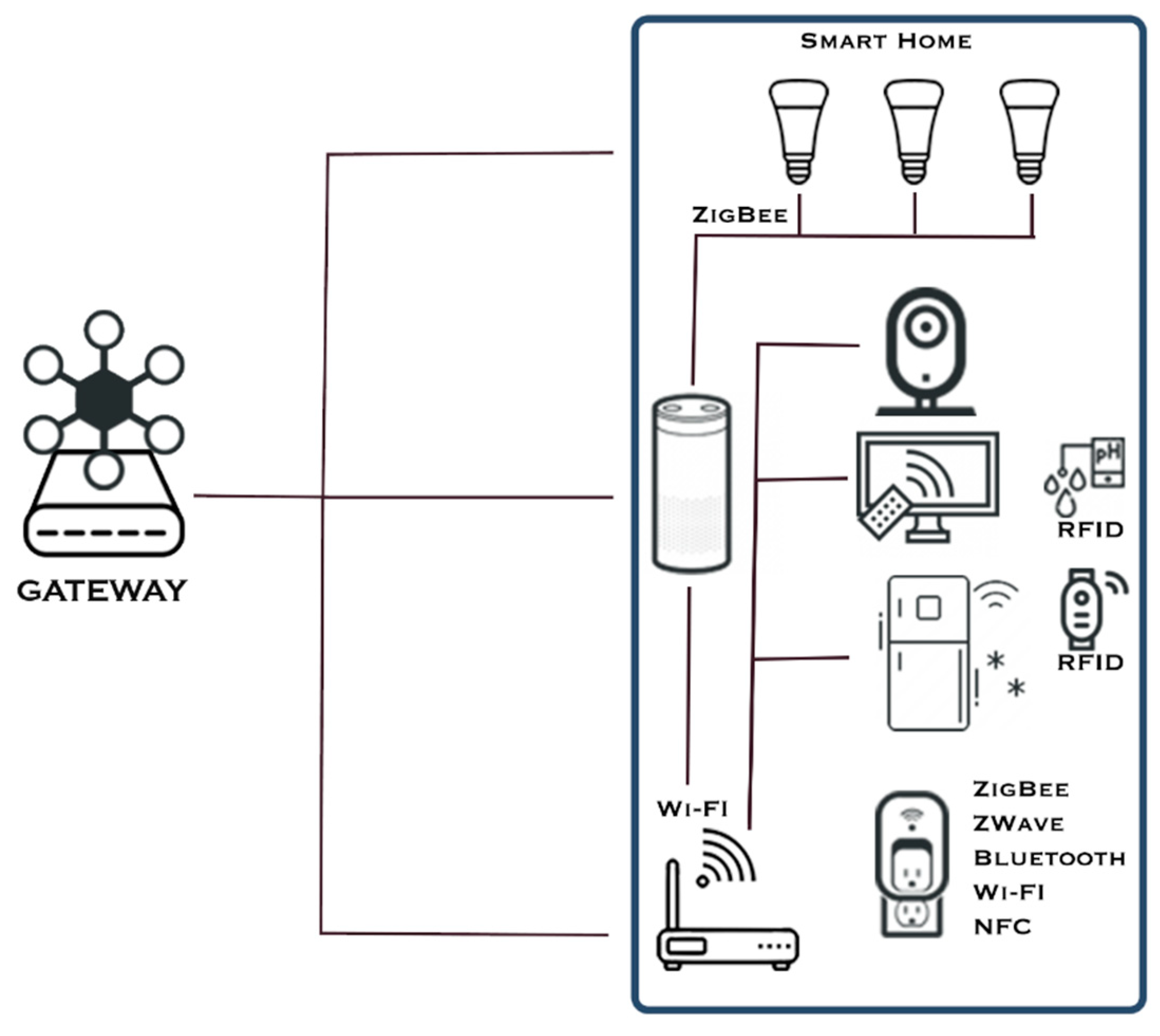
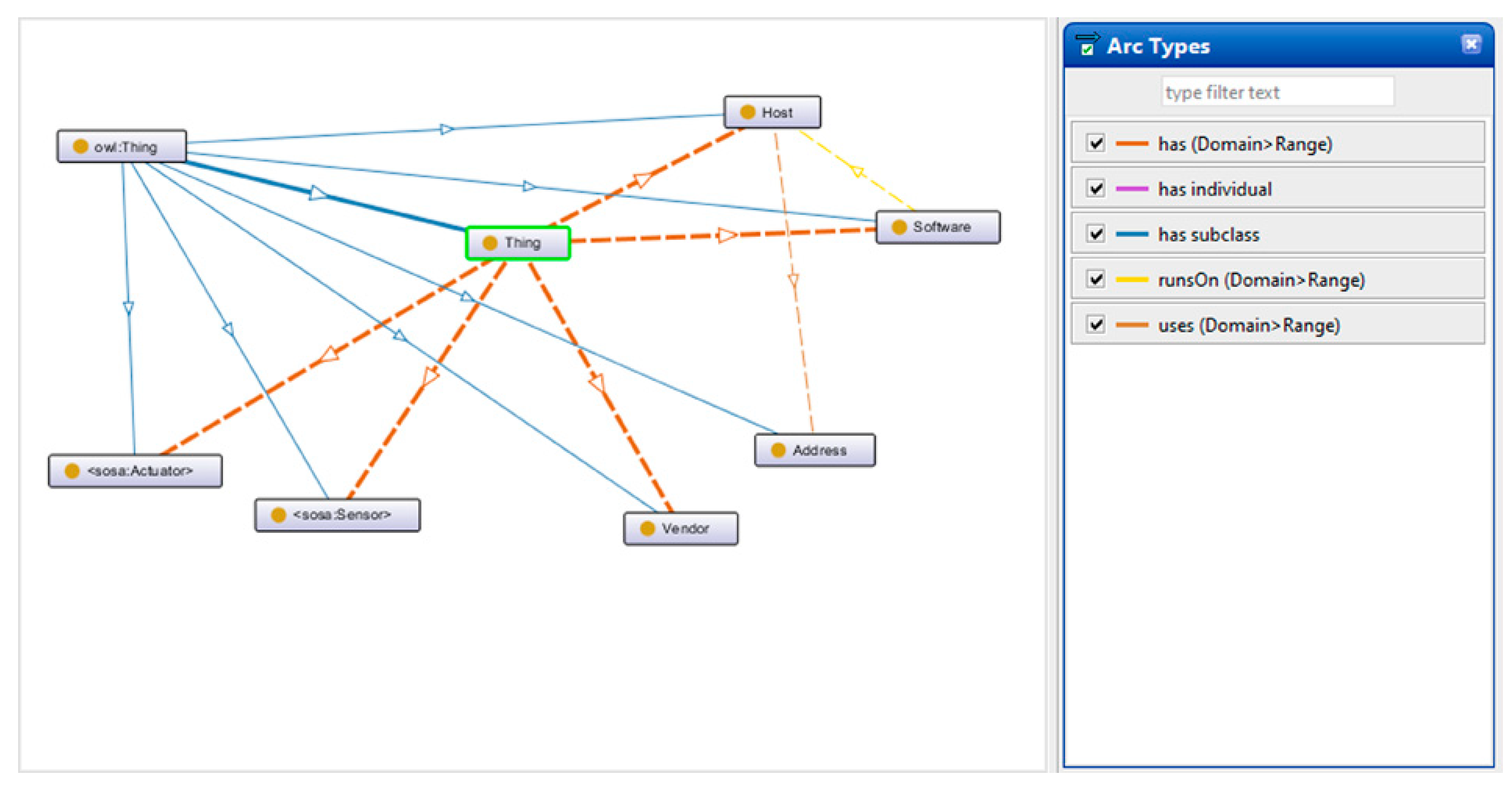
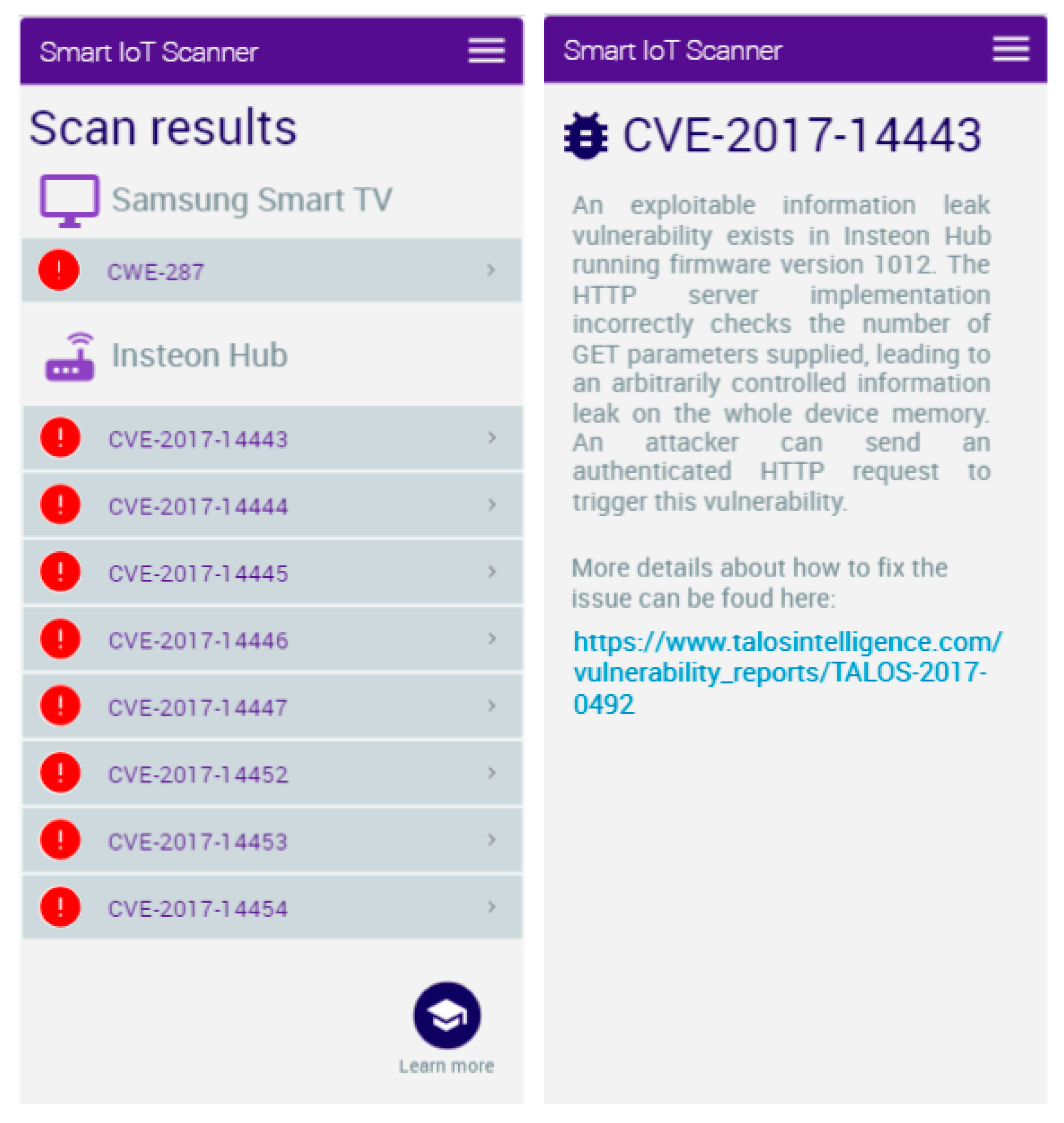
| No. | Key Term | Description | CVEs |
|---|---|---|---|
| 1 | Actuator | physical component | CVE-2014-9786, CVE-2014-9782, CVE-2014-9877 |
| 2 | AMQP (Advanced Message Queuing Protocol) | protocol | CVE-2018-8119, CVE-2018-8030, CVE-2018-1298, CVE-2018-11087, CVE-2018-11050, CVE-2017-8045, CVE-2017-15702, CVE-2017-15701, CVE-2017-15699, CVE-2017-11408, CVE-2016-4974, CVE-2016-4432, CVE-2016-2173, CVE-2015-5240, CVE-2015-0862, CVE-2015-0203, CVE-2014-8711, CVE-2014-2814, CVE-2012-4458, CVE-2012-4446, CVE-2012-3467 |
| 3 | Arduino | platform | CVE-2018-17614, CVE-2015-7833, CVE-2015-4590 |
| 4 | Barcode | technology | CVE-2018-5221, CVE-2014-8672, CVE-2014-7897, CVE-2014-6869 |
| 5 | Belkin WeMo | product | CVE-2018-6692, CVE-2013-6952, CVE-2013-6951, CVE-2013-6950, CVE-2013-6949, CVE-2013-6948 |
| 6 | CoAP (Constrained Application Protocol) | protocol | CVE-2018-18225, CVE-2018-14367 |
| 7 | Eclipse Kura | framework | CVE-2017-7649 |
| 8 | Eclipse Mosquitto | framework | CVE-2018-12543, CVE-2017-9868, CVE-2017-9132, CVE-2017-9131, CVE-2017-7654, CVE-2017-7653, CVE-2017-7652, CVE-2017-7651, CVE-2017-7650 |
| 9 | Embedded system | technology | CVE-2017-12823 |
| 10 | HART (Highway Addressable Remote Transducer) | protocol | CVE-2018-16059, CVE-2015-6463, CVE-2015-3977, CVE-2014-9203, CVE-2014-9191, CVE-2013-2476 |
| Project | F1 Score for Entity Recognition | Number of Classes | F1 Score for Relation Extraction | Number of Relations |
|---|---|---|---|---|
| [7] | 0.8 | 7 | Not Available | Not Available |
| [27] | 0.49 | 5 | 0.19 | Not Available |
| [28] | 0.73 | 5 | Not Available | Not Available |
| [29] | 0.67 | 4 | 0.55 | 2 |
| [32] | 0.81 | 18 | 0.53 | 33 |
| Our work | 0.68 | 17 | 0.46 | 30 |
© 2019 by the authors. Licensee MDPI, Basel, Switzerland. This article is an open access article distributed under the terms and conditions of the Creative Commons Attribution (CC BY) license (http://creativecommons.org/licenses/by/4.0/).
Share and Cite
Georgescu, T.-M.; Iancu, B.; Zurini, M. Named-Entity-Recognition-Based Automated System for Diagnosing Cybersecurity Situations in IoT Networks. Sensors 2019, 19, 3380. https://doi.org/10.3390/s19153380
Georgescu T-M, Iancu B, Zurini M. Named-Entity-Recognition-Based Automated System for Diagnosing Cybersecurity Situations in IoT Networks. Sensors. 2019; 19(15):3380. https://doi.org/10.3390/s19153380
Chicago/Turabian StyleGeorgescu, Tiberiu-Marian, Bogdan Iancu, and Madalina Zurini. 2019. "Named-Entity-Recognition-Based Automated System for Diagnosing Cybersecurity Situations in IoT Networks" Sensors 19, no. 15: 3380. https://doi.org/10.3390/s19153380
APA StyleGeorgescu, T.-M., Iancu, B., & Zurini, M. (2019). Named-Entity-Recognition-Based Automated System for Diagnosing Cybersecurity Situations in IoT Networks. Sensors, 19(15), 3380. https://doi.org/10.3390/s19153380





